Regional Newsletters
Statewide Update
 Fresno Bee: Listen to Governor Gavin Newsom’s HSR Plans and Expectations — 11/08/19
Fresno Bee: Listen to Governor Gavin Newsom’s HSR Plans and Expectations — 11/08/19
There was a lot happening at high-speed rail in the last few weeks, and the Central Valley was at the heart of the action. From the Regions Rise economic summit, to Governor Newsom’s reaffirmation of building high-speed rail in the Valley, to visits from our Swedish transportation partners, construction progress and field hearings, check out the latest for high-speed rail: It’s happening.
CEO Report
Earlier this month, several members of our Authority staff and the Board of Directors, including Chairman Lenny Mendonca, participated in the Governor’s “Regions Rise” Economic Summit in Fresno. Also, in this month’s CEO report read about the Record of Decision reached for the Bakersfield Locally Generated Alternative and the progress being made on the 2020 Business Plan.
High-Speed Rail Receives Top National Sustainability Ranking
California’s high-speed rail project has again received a 5-star rating as one of the top sustainable rail projects in North America. The ranking is courtesy of the Global Real Estate Sustainability Benchmark (GRESB) Infrastructure Assessment, the leading benchmark for environmental, social and governance policies, practices, and performance of real estate and infrastructure investments around the world.
The California High-Speed Rail Authority’s 2019 Sustainability Report: Energizing Economic Revitalization highlights the Authority’s sustainability activities for 2018 in accordance with the Global Reporting Initiative (GRI) Standards Core Option – the world’s leading and most widely adopted sustainability reporting framework.
“It is great to see California’s High-Speed Rail Authority continuing to report to GRESB to benchmark its performance against similar infrastructure projects and assets, and against the entire GRESB dataset annually,” said GRESB Infrastructure Director Rick Walters. “This ongoing commitment to sustainability is affirmed further this year by California’s project moving back up into the top quintile and therefore receiving a 5-star rating. The Authority’s track record on sustainability, as measured by GRESB, will surely position the asset well when it comes to attracting private sector investment in the future.”
As of mid-2018, the project’s total investments into the system statewide had created approximately $7.6 billion in total economic activity across the state.
Construction Progress in the Central Valley
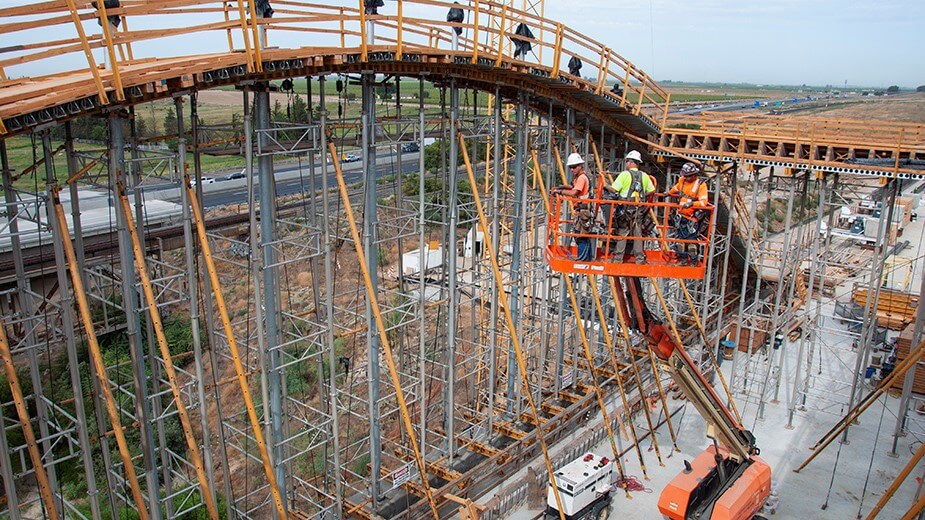
In north Fresno, crews are working over the San Joaquin River and placing concrete at the east archway of the viaduct. Nighttime closures kicked off on State Route 99 as crews began the placement of precast concrete girders over the highway to connect the Cedar Viaduct. Just outside of downtown Fresno, crews have completed the walls, floor and lid of the Fresno Trench and are now placing concrete for the intrusion protection barrier walls that will separate the high-speed rail corridor and Union Pacific Railroad. See all this and more in the latest Construction Update, out now!
Investing in California Small Businesses
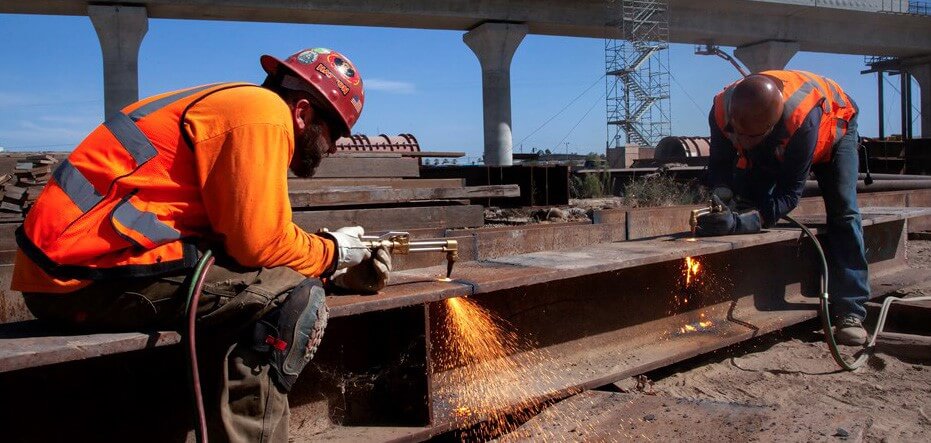
The latest version of the Investing in California Small Businesses newsletter is out now. This issue highlights veteran-owned businesses and resources the Authority has available for veteran-owned businesses. Features include She-Marine Construction Supply, a Disabled Veteran Business Enterprise (DVBE) owned by a U.S. Marine veteran, and Wayne Gross, an outreach liaison for the Department of General Services and a U.S. Air Force veteran.
Environmental Schedule Updated
This fall, the Authority made major progress in clearing the northern and southern ends of the high-speed rail project in the Central Valley. On November 8, the Authority issued the Record of Decision for the Locally Generated Alternative – the final 23-mile route between Shafter and Bakersfield. This decision allows the Authority to move towards project construction in the area. In the north, on October 28, the public comment period closed for the Merced to Fresno Section: Central Valley Wye Draft Supplemental Environmental Impact Report/Environmental Impact Statement. The Authority is currently reviewing the comments received, and plans on issuing a Final Supplemental EIR/EIS in July of next year. On July 23, 2019, the State of California announced that it had received approval from the Federal Railroad Administration to assume its federal environmental review responsibilities under the National Environmental Policy Act and other federal environmental laws. In 2020, the Authority anticipates releasing the remaining documents for the full 520-mile system from San Francisco to the Los Angeles area to get those alignments identified as soon as possible.
| Project Segment | Draft EIR/EIS | Revised ROD Date | Months to ARRA 12/2022 Deadline from ROD Date |
|---|---|---|---|
|
Locally Generated Alternative (F – B)* *Complete |
July 2019 | October 2019 | 39 |
| Central Valley Wye (M – F) | September 2019 | September 2020 | 27 |
| Bakersfield to Palmdale | January 2020 | February 2021 | 22 |
| Burbank to Los Angeles | February 2020 | January 2021 | 23 |
| Palmdale to Burbank | February 2020 | August 2021 | 16 |
| San Jose to Merced | March 2020 | April 2021 | 20 |
| San Francisco to San Jose | April 2020 | June 2021 | 18 |
| Los Angeles to Anaheim | November 2020 | December 2021 | 12 |
Northern California Regional Update
November 2019
The Northern California Region Achieves Critical Milestone
At its September meeting, the Authority’s Board of Directors concurred with staff’s recommendations for the identification of Preferred Alternatives in Northern California. This is an important step and paves the way for the Authority staff to now proceed with finalizing and releasing the draft environmental documents for the San Francisco to San Jose and San Jose to Merced Project Sections.
The draft environmental documents are due out in March 2020 for the San Jose-to-Merced project section and April 2020 for the San Francisco-to-San Jose project section. The documents are currently going through final internal reviews, before being vetted with cooperating agencies prior to the public release.
Although the Board has identified preferred alternatives, all alternatives will be evaluated equally in the draft environmental documents. The final route decisions will be made at the conclusion of the environmental review process. After release of the draft environmental documents, there will be a 45-day public comment period during which the Authority’s outreach team will hold three open houses and a public hearing in each project section.
In the San Jose to Merced project section, the Board identified Alternative 4 as the Preferred Alternative. Alternative 4 utilizes a blended configuration between San Jose and Gilroy in the existing Caltrain and Union Pacific Railroad corridors before continuing to a dedicated high-speed rail alignment through Pacheco Pass.
In the San Francisco to San Jose project section, the Board identified Alternative A as the Preferred Alternative. Alternative A utilizes a blended configuration between San Francisco and San Jose within the existing Caltrain corridor. This alternative includes a light maintenance facility on the east side of the tracks in Brisbane and does not include additional passing tracks.
Caltrain Board Adopts Ambitious Service Vision

At its October meeting, Caltrain’s Board of Directors voted to adopt a long term 2040 Service Vision, defining an ambitious plan for growing service over the next 20-plus years. The Caltrain Business Plan’s 2040 Service Vision sets a target for the railroad that ensures Caltrain can continue to meet the growing mobility needs of the region while making the best use of the many projects and investments planned and under construction along the corridor.
The Service Vision the Caltrain Board of Directors adopted maintains the commitment to a shared blended system on the Peninsula that will accommodate both robust Caltrain service and the Authority’s high-speed rail service. We congratulate Caltrain on this significant accomplishment.
To read about the Caltrain Business Plan, visit:
Carl Guardino – San Jose’s Visionary for Sustainability
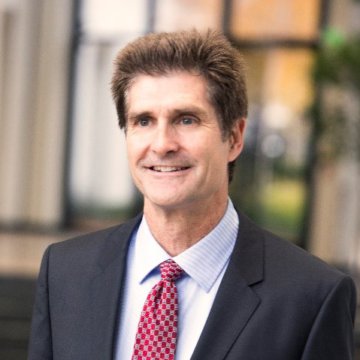
For nearly three decades as CEO and President of the Silicon Valley Leadership Group, Carl Guardino has advocated for transportation and housing improvements that emphasized the fundamental tenants of sustainability – including lobbying hundreds of transit-oriented affordable housing projects and pushing for rail and transportation enhancement projects, including high-speed rail, improvements for Caltrain, and extending BART to San Jose and into Santa Clara County. He’s also been a pivotal voice in the long-term plan to transform Diridon Station in San Jose.
To read about the Guardino’s work, visit https://www.buildhsr.com/facesofhsr/#san_joses_visionary_for_sustainability
BART Moving Swiftly to Bring Service to San Jose and Santa Clara County
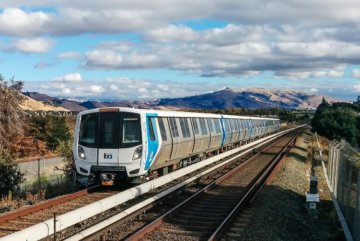
The Santa Clara County Valley Transit Authority’s BART Silicon Valley Extension Program (BSV) has outlined its plans to expand BART Service into Santa Clara County, bringing frequent and reliable regional service to over 1.7 million county residents. The ambitious projects are being built in two phases:
- Phase I will extend service from Alameda County into Santa Clara County, with stops at Milpitas and Berryessa/North San Jose and is expected to open by the end of the year.
- Phase II, which is currently in the design and engineering stage, will extend service from Berryessa Transit Center to stations at Alum Rock/28 Street, downtown San Jose, Diridon Station, and Santa Clara.
The effort to bring BART into Santa Clara County has been decades in the making. Faced with growing congestion along the I-880 corridor, a major investment study was conducted in 2001, which identified the need for transit alternatives and laid the groundwork to start the environmental process for the BART to Silicon Valley Extension Program.
The original project would have extended service in one, 16-mile extension from South Fremont to Santa Clara. The VTA Board Committed to building the project in two phases in February 2009, with Phase I carrying passengers to Berryessa/North San Jose and Phase II serving downtown San Jose and Santa Clara. Phase I broke ground in 2012 and is anticipated to open for passenger service later this year. Phase II has completed the environmental clearance process and is currently in working to finalize the design and engineering.
While both project have substantial local, regional, and state funds, the Phase II extension project received a major funding boost in August when the United States Department of Transportation allocated $125 million to help support the project, making BART the first agency to receive funding under the Federal Transit Administration (FTA) Expedited Project Delivery Pilot Program.
The Future is Fresno: Exploring Valley-to-Valley Opportunity
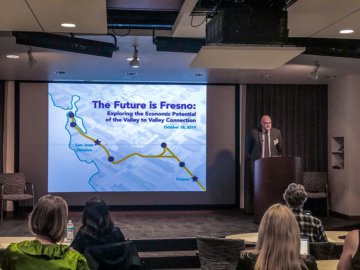
The Bay Area Council Economic Institute recently released a new report, “The Future is Fresno: How the Valley to Valley Connection Can Propel California’s Long-Term Prosperity,” which provides an economic blueprint for the importance of the connection between the to the Central Valley and Silicon Valley.
Over the past several weeks, the Bay Area Council has released a series of snippets from its report looking at the economic value of the connection between the Bay Area and the Central Valley. This culminated in the release of the full report at the California Economic Summit, which was held in Fresno.
The report highlights the importance of connecting the Central Valley and the Silicon Valley with fast high-speed rail service to create new economic opportunities in Fresno and other Central Valley cities, while also relieving some of the housing burden felt by Bay Area residents today. Looking at what it would mean for Fresno to be one hour from San Jose, the report explains how state and local policies can leverage the investment being made in transportation and help continue to propel the State’s economy.
The full report is available at http://www.bayareaeconomy.org/the-future-is-fresno-exploring-the-valley-to-valley-connection/.
Diridon Integrated Station Concept Plan (DISC)
After a year of analysis and community outreach, the Partner Agencies in charge of the Diridon Integrated Station Concept Plan (DISC) presented to the Diridon Joint Policy Advisory Board (JPAB) a recommendation for a future concept layout for San Jose’s Diridon Station.
The DISC Partnership – comprised of representatives from the California High-Speed Rail Authority, the City of San Jose, the Peninsula Joint Powers Board (Caltrain), and the Santa Clara Valley Transportation Authority (VTA) –presented a “concept layout” in November as the foundation of the future of Diridon Station, which is projected to evolve into one of the busiest intermodal hubs in the state. The partnership was formed to ensure that an integrated approach to the development of the Diridon Station Area was achieved by addressing both transportation and land use in the station area.
The Partner Agencies hired a consultant team led by Arcadis and Benthem Crouwel Architects (Team ABC) to aid in preparing the DISC. Team ABC led the partners through a year-long series of workshops and meetings that focused on both ambitions for the station, as well as making sure that the requirements for each partner agency are incorporated.
Over the past year, the Partner Agencies worked with Team ABC to develop the spatial layout for the future station that included completing supporting analyses. The presentation to the JPAB is recommending that the policy boards and/or executive management of the four Partner Agencies support the concept layout for further development. Future DISC work will continue to move forward in coordination with the partner agencies and their planning processes and projects.
The Concept layout planning process took into consideration the following items:
- Alignment and vertical profile of the heavy rail tracks at the station, as well as track approaches into the station from the north and the south.
- Location of passenger rail concourse(s) and heavy rail passenger platforms.
- Integration of all high-capacity modes at the station, including commuter and intercity rail, BART, light rail, local bus, and a future airport connector.
- Pedestrian and bicycle access to and through the station, as well as facilities for emerging modes of “micro-mobility” such as e-scooters.
- Facilities for other access modes and private vehicles, including long-distance bus, private shuttles, taxi, transportation network companies (TNC), kiss-and-ride, and park-and-ride.
- Urban integration (i.e., the connection between the station, track infrastructure, and surrounding neighborhoods and potential for amenities, such as plazas and community gathering space).
For the Layout Development Report and additional background information, visit the project website at https://www.diridonsj.org/disc.
Southern California Regional Update
November 2019
Authority Debuts Agreement to Advance Work at LA Union Station
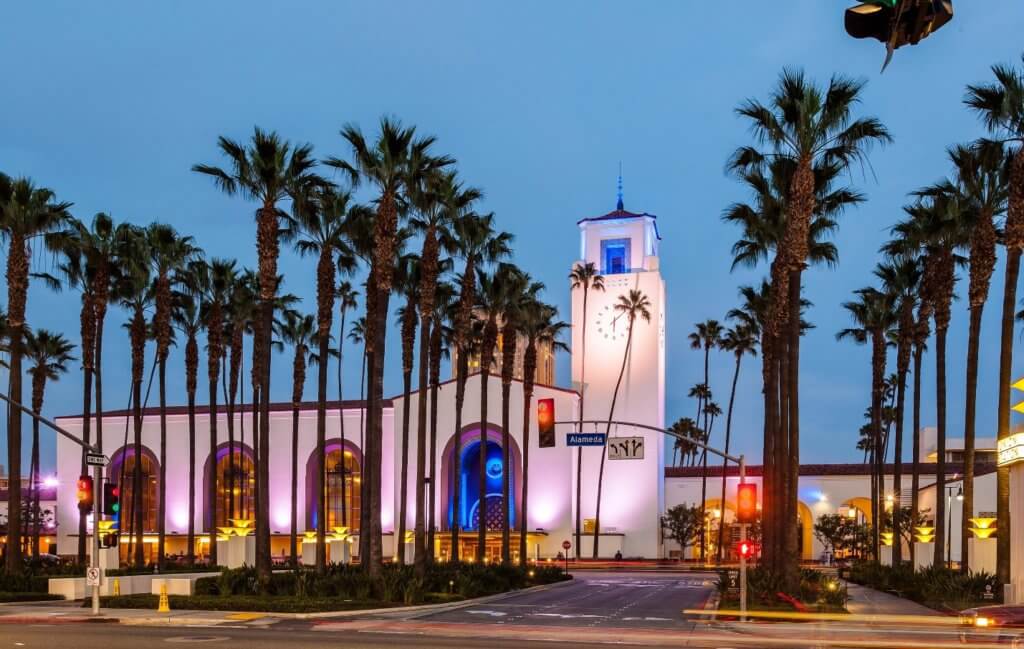
As construction of the country’s first true high-speed rail system moves forward in California’s Central Valley, so too are other important investments in Southern California.
The recent debut of a Memorandum of Understanding (MOU) with the Los Angeles County Metropolitan Transportation Authority (Metro) highlights the centerpiece of those investments, as more than $400 million in voter approved Proposition 1A high-speed funds will contribute to the transformative Link Union (Link US) project at Southern California’s historic Los Angeles Union Station (LAUS).
The MOU directs all parties to establish a Link US Executive Steering Committee to coordinate and facilitate delivery of the project which, upon completion, will transform how Southern California’s regional transit system operates, further paving the way for future high-speed rail service at LAUS. The committee will in turn ensure that all partners work together to allow the California High-Speed Rail Authority (Authority) to secure approval and release of $423 million in Proposition 1A funds, appropriated by the California Legislature pursuant to Senate Bill (SB) 1029, which was signed into law in 2012. In addition to enabling future use by California high-speed rail, the agreement also ensures that the Link US project will better serve Metro and state-supported intercity trains as well as other passenger and freight rail providers.
The Link US project will allow trains to enter and exit the station from both the existing northern tracks and new tracks to the south over the 101 freeway. This is anticipated to significantly increase capacity for rail service while reducing train idling times, growing the station’s capacity with a new expanded passageway under the tracks and new platforms, escalators and elevators.
A copy of the MOU can be found at this link: https://hsr.ca.gov/docs/programs/statewide_rail/proj_sections/CHSRA_LA_Metro_Link_MOU.pdf
The Authority’s commitment to environmentally clear the Burbank-Anaheim corridor by 2022 also paves the way for additional investments to be made by other operators in this important and heavily used rail corridor. The Authority has already contributed $398 million for connectivity projects, including $115 million for the Regional Connector Transit Corridor project for a total investment of $1.3 billion. The Authority’s contributions are an important part of the state’s overall investment of $4.4 billion in rail infrastructure in Southern California. More information about state investments in Southern California rail transit projects can be found on our fact sheet at https://hsr.ca.gov/docs/communication/info_center/factsheets/State_Investment_Southern_California.pdf
Palmdale Plans to be High-Speed Rail Ready with New Multi Modal Transportation Station
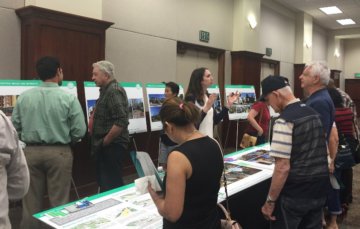
Authority staff was a special guest at the October Station Area Plan Community Open House in Palmdale. More than 200 community members attended the meeting to learn more about plans for their state-of-the-art transportation station. The meeting was the last in a series for 2019 that shared the city’s plans and renderings of the Palmdale Transportation Center with the community and other stakeholders. Community members were very enthusiastic about the city’s plans for the station, the design concepts and the potential for economic development and growth in the region.
“We plan to be rail ready for high-speed rail, the potential Virgin Trains and the High Dessert Corridor,” said Mayor Steve Hofbauer. “We are planning a station (area) that will be ready to receive California high-speed rail as soon as the Authority can get the train here.”
Members of the city’s Palmdale Transportation Plan team presented the vision for the station that included:
- Improving transportation by enhancing multi modal options and increasing use of alternative transportation modes.
- Enhancing the local economy with short and long-term development opportunities for local business owners.
- Attracting new residential and commercial development activities.
- Promoting smart growth with a resilient, transit-oriented community with a diversified transportation system.
Attendees visited the high-speed rail table to discuss plans for the high-speed rail project and how soon the Authority might be planning to begin construction in the region. Community members received information specific to the Bakersfield to Palmdale project section as well as statewide information about the California High-Speed Rail Project.
The Authority is currently planning for Community Open Houses in the Palmdale to Burbank project section in early 2020. These meetings will provide updates on the project, in-depth information about the program and information about the Draft Environmental Impact Report/Environmental Impact Study (EIR/EIS).
Virgin Trains USA/Brightline Project Receives Funding Approval

The possibility to ride a high-speed train to Las Vegas from Southern California came closer to reality on October 23 when a bond request on behalf of Virgin Trains USA/Brightline for $3.25 billion was approved by the Board of Directors of the California Infrastructure and Economic Bank (IBank). “Moving toward clean, green electrified high-speed rail is the future,” said Lenny Mendonca, Director of the Governor’s Office of Business and Economic Development and IBank Chair.
Virgin Trains USA and Brightline initiated a partnership in 2018 which will begin construction on the 130-mile Las Vegas to Victorville route in 2020 with a goal to provide passenger service by 2023. The California High-Speed Rail Authority (Authority), along with CalSTA and Caltrans, entered into a Memorandum of Understanding (MOU) with Virgin Trains USA/Brightline to evaluate the opportunity to connect both systems in Palmdale, and evaluate interoperability and opportunities for joint purchases of materials, rolling stock and ticketing systems.
Coordination between Virgin Trains USA/Brightline and the Authority could provide synergy to both projects by leveraging two systems for increased ridership and possibly attract future public/private partnerships for the Authority’s Palmdale to Los Angeles/Anaheim project delivery and operations. Within the next 18-24 months, there will be 350 miles of electrified high-speed rail routes under development including the construction of the Las Vegas to Victorville route. The Virgin Trans USA/Brightline route will connect to the Authority’s system at the Palmdale Station through the High Desert Corridor (HDC).
An HDC sustainability study in 2017 considered how a high-speed rail connection, a bikeway and green energy could be integrated. Sustainability benefits include the reduction of greenhouse gas emissions from vehicle traffic on Interstate 15 and reduction of travel time to Las Vegas from Southern California, which can take 4 hours or more by car.
Reaching Out to Southern California Communities
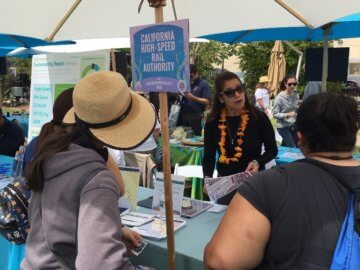
Kicking off 2019, the Authority participated at the National Association of Minority Contractors (NAMC) event at Los Angeles Trade Tech College on January 31st. Staff hosted an exhibit table to share insights about doing business with government agencies and the Authority’s Small Business Program.
We were out at Earth Day events in April to talk about the all-electric high-speed rail system, part of the climate change solution, that will run on renewable energy and displace tons of greenhouse gas emissions during operation. SoCal staff participated in Environmentality for Disney employees, Cal State Fullerton’s Earth Day and many other local events. At the Association of Southern California Engineers International Conference on Sustainable Infrastructure in November, Authority Director of Sustainability Meg Cederoth and Climate Analyst Annika Ragsdale were part of the sustainability dialogue. While Meg delivered a presentation, Annika participated on a panel about resiliency standards.
The Authority staffed exhibit tables at several unique events including the 80th Anniversary Celebration at Los Angeles Union Station where hundreds of families enjoyed festive and fun rail exhibits. At the California League of Cities in Long Beach in October, elected officials and city staff heard the latest project and construction updates, with many voicing support for future high-speed rail service.
We participated and sponsored tree planting workshops in Los Angeles and Orange Counties, where over 750 ‘carbon sequestering’ trees were planted with the help of Circle 3.0, a team made up of the California Urban Forest Council, West Coast Arborist, Inc. and the Western Chapter International Society of Arboriculture.
The Authority appreciates the opportunity to reach out to communities through diverse events throughout the year and looks forward to 2020, including celebrations of the 50th Anniversary of Earth Day and project section public meetings.
Quarterly Newsletter Archive
- Spring 2023 All Aboard Newsletter
- Winter 2023 Quarterly Newsletter
- Fall 2022 Quarterly Newsletter
- Summer 2022 Quarterly Newsletter
- Spring 2022 Quarterly Newsletter
- Winter 2022 Quarterly Newsletter
- Fall 2021 Quarterly Newsletter
- Summer 2021 Quarterly Newsletter
- Regional Newsletter - May 2021
- Regional Newsletter - February 2021
- Regional Newsletter - November 2020
- Regional Newsletter - August 2020
- Regional Newsletter - June 2020
- Regional Newsletter - February 2020
- Regional Newsletter - November 2019
- Regional Newsletter - August 2019
- Summer 2023 All Aboard Quarterly Newsletter
- Fall 2023 All Aboard Quarterly Newsletter
- Winter 2022 Quarterly Newsletter
- Regional Newsletters – Aug 2019
- Regional Newsletters – Nov 2019
- Regional Newsletters – Feb 2020
- Regional Newsletters – June 2020
- Regional Newsletters – Aug 2020
- Regional Newsletters May 2021
- Fall 2021 Quarterly Newsletter
- Summer 2021 Quarterly Newsletter
- Spring 2022 Quarterly Newsletter
- Summer 2022 Quarterly Newsletter
- Regional Newsletters – Nov 2020
- Winter 2023 Quarterly Newsletter
- Regional Newsletters – Feb 2021
- Spring 2023 All Aboard Quarterly Newsletter
- Fall 2022 Quarterly Newsletter
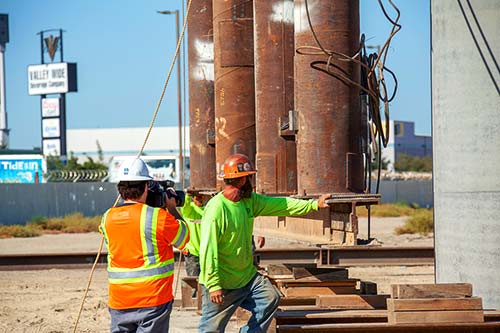
The California High-Speed Rail Authority makes every effort to ensure the website and its contents meet mandated ADA requirements as per the California State mandated Web Content Accessibility Guidelines 2.0 Level AA standard. If you are looking for a particular document not located on the California High-Speed Rail Authority website, you may make a request for the document under the Public Records Act through the Public Records Act page. If you have any questions about the website or its contents, please contact the Authority at info@hsr.ca.gov.

